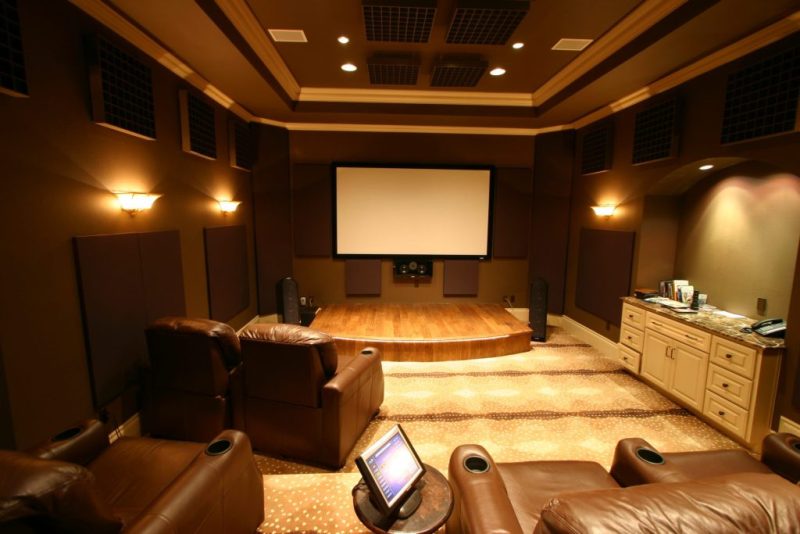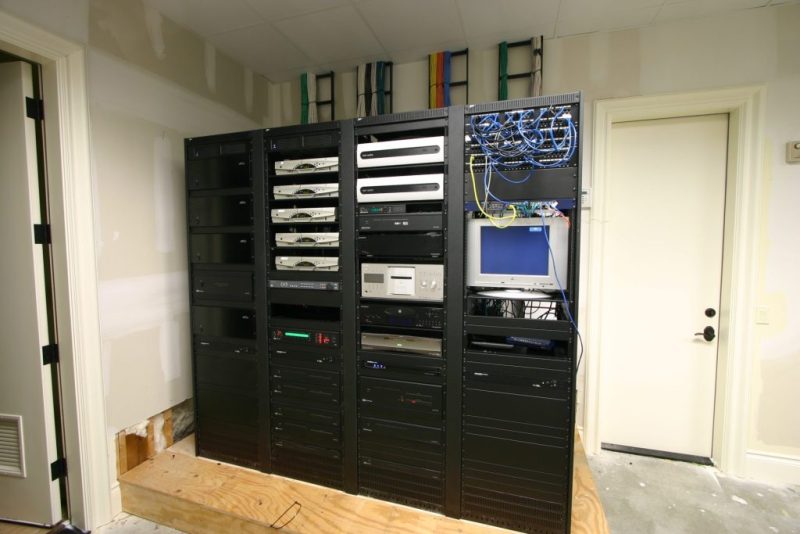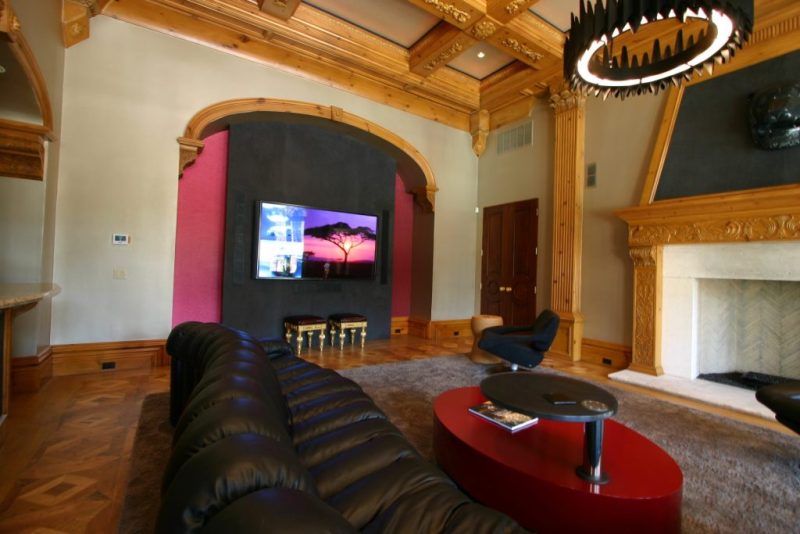Designing the Perfect Home Theater Setup
Contents
Creating a home theater is an exciting process that requires careful planning and thought. With the proper setup, you can turn your living room into an immersive entertainment experience. This article will provide a comprehensive guide to designing the perfect home theater. We’ll review the essential components, discuss tips on selecting the right equipment, and offer advice on creating an optimal viewing environment.
Essential Components for Ultimate Home Theater
Having an ultimate home theater is a goal for many movie lovers; it provides the best experience of being in a theater but from the comfort of your home. There are several essential components to consider and incorporate into your setup to achieve this feat.

A quality home theater setup typically includes a high-definition television or projector system, an amplifier, and multiple speakers configured for optimal sound delivery. Additionally, many plans come with built-in streaming capabilities that give users access to thousands of movies and TV shows over the internet. Homeowners can also use their home theaters for other purposes, such as playing video games or watching sports events in stunning clarity and detail. The options are virtually limitless when using a home theater system.
Audio
The first component to consider when designing your ultimate home theater is audio. Your audio system should be able to provide clear sound that can fill up the entire room with no distortion. This includes investing in quality speakers and possibly even a sub-woofer if you have space.

Several speakers are available depending on your specific needs, each designed for different purposes, such as surround sound systems or bass enhancement. Additionally, an amplifier will help boost the audio output so you can feel each scene come alive. Subwoofers provide additional depth to complete your cinematic journey by adding extra low-end frequencies for maximum impact during action scenes.
Video
Next, you should look into getting a good projector or television with 4K Ultra HD visuals and Dolby Vision capabilities that will give you an immersive viewing experience like no other. This will ensure that every scene looks crisp and clear on screen. If you don’t want to invest in an expensive television set, consider buying an advanced projector with built-in speakers. It will still deliver an impressive viewing experience without taking up too much space in your room.
Video components are the key to creating the ultimate home theater. From projectors to streaming devices, a variety of video hardware is available to bring your dream theater experience into your living space. Whether you’re looking for a top-of-the-line display or an affordable projector, here is what you need to know about setting up the perfect home theater system.
Streaming
Streaming services are revolutionizing how we watch TV and movies. As technology advances, so make our entertainment choices. Streaming services are now one of the most popular ways to enjoy your favorite shows, movies, and more from the comfort of your home theater.
From Netflix to Hulu Plus and everything in between, streaming services provide various options for building your ultimate home theater experience. With thousands of titles available at any given time, you can choose from multiple genres such as drama, comedy, horror, action/adventure, and more. You can also find classic films from decades past or binge-watch entire seasons of original series like House Of Cards and Stranger Things with just a few clicks.
Not only is it convenient to access all these shows without ever leaving your couch – but it’s also affordable!
The Benefits of a Home Theater System
Home theater systems provide movie lovers with the ultimate cinematic experiences. Homeowners can enjoy unparalleled audio-visual performance by upgrading from a regular television and stereo to an entire home theater system. From custom seating arrangements to immersive surround sound speakers, these systems allow viewers to experience films just as they would at their local cinema.

- Enhanced Movie Experience
- Surround Sound Bliss
- Improved Audio Quality
- Theater-Like Ambience at Home
- More Affordable than a Cinema Outing
- Easy Installation and Maintenance
Having a home theater setup means you don’t have to spend money on tickets or snacks at the theater – instead, you can relax at home while enjoying the same entertainment experience! Also, having a dedicated space where all your audio-visual equipment is set up will allow you to get the most out of any media content – from sports games to concerts.
Tips to Achieve the Best Audio Quality
Good audio quality is essential for achieving the full home theater experience. Quality sound is key whether you’re a movie buff or an audiophile. Here are some tips to get the best audio quality out of your home theater setup:
Choose High-Quality Audio Equipment
The first step in achieving great sound is selecting the right speakers. Make sure you buy speakers that match your receiver’s output and can handle your room size and type of content. Look for speakers with good frequency response, power handling, sensitivity, and impedance values to ensure maximum performance. Additionally, please pay close attention to crossover settings, as these help direct specific frequencies to their intended destinations within your system.
Invest in Quality Cables and Connections
Next, ensure you have the correct wiring for all your components so they can communicate without any issues. Also, consider how far away each piece will be from others and choose appropriate cable lengths accordingly.
Calibrate Your System for Maximum Performance
The calibration process begins with understanding your system’s frequency response range. Different components and settings will affect this range, so it’s essential to familiarize yourself with your system’s capabilities before making any adjustments. Once you have a good grasp of how your system works, you can begin by adjusting the sound levels of each speaker to match the main output level. This will help ensure that all speakers are balanced and that no single channel is overpowering another.
Experiment with Different Speaker Placements
Experimenting with different speaker placements is one of the best ways to get the most out of your audio setup. Whether you’re an audiophile, a sound engineer, or just a casual listener, it’s essential to understand how proper speaker placement can make all the difference in how your music sounds. By experimenting with different arrangements and angling speakers throughout your listening space, you can achieve superior sound quality that will elevate any experience.
The key to successful experimentation lies in understanding which placement works best for each room. Start by placing the speakers at ear level and try them as close together as possible while still leaving some distance between them. Then move around each speaker one at a time while listening critically to determine where they sound their best in relation to other objects in the room.
Utilize Digital Signal Processing (DSP)
Digital Signal Processing (DSP) is a powerful tool for improving home theater performance. Utilizing Digital Signal Processing, one can quickly improve the audio and video experience in their home theater system. This could include dynamically adjusting audio levels to accommodate different movie or TV show genres while optimizing sound to fit the size of the room.
Moreover, DSP helps bring out more details in soundtracks and visuals due to its ability to reduce background noise and enhance low-level signals. With advanced algorithms such as reverb, equalization, and Dolby Atmos, DSP can refine the listening experience by providing accurate spatial imaging for enhanced realism. Smart speakers with built-in DSP capabilities can also provide feat-convenient ures such as voice control and automatic calibration forby Atmos surround sound
Dolby Atmos surround sound is the latest home theater technology, providing an immersive listening experience. It combines audio processing with revolutionary speaker placement to create a 3D soundscape that envelops viewers and puts them in the middle of the action. Unlike traditional 5.1 or 7.1 surround systems, Dolby Atmos adds two additional layers – height and overhead channels – for an even more dynamic listening experience. With up to 64 speakers arranged in a three-dimensional array, it creates unprecedented realism and clarity of sound within any room configuration.
Unlike conventional surround systems, which rely on reflected sound from walls and ceilings to give a sense of depth, Dolby Atmos uses direct sound from ceiling-mounted speakers to provide realistic spatial cues that make you feel as though you are part of the scene being played out onscreen.
Creating an Immersive Viewing Experience
Creating an immersive viewing experience is today’s must-have for home theaters. With technological advancements, consumers can turn their living space into a high-end cinema. Home theater systems have become more popular, allowing users to enjoy films with vibrant colors, lush sounds, and crisp images.
AchiThe right equipment to achieve an immersive viewing experience in your home theater, stage-definition televisions, is essential to get the most out of any movie or show. Additionally, investing in a sound system with at least four speakers and a subwoofer will help create that cinematic atmosphere you’re looking for. To optimize your viewing experience even further, consider adding lighting controls, window treatments, and comfortable seating options.
4K Ultra HD
4K Ultra HD is the latest high-definition television technology, providing viewers with vivid and lifelike visuals. With four times the resolution of standard HD, 4K Ultra HD delivers an unprecedented viewing experience that immerses viewers in a world of stunning clarity and detail. This new technology offers an incredibly realistic picture quality that brings movies, sports, and video games to life like never before.

Thanks to advances in hardware, 4K Ultra HD TVs are now more accessible than ever. Most televisions on the market today have 4K resolution capabilities, making it easy for consumers to upgrade their home entertainment systems at an affordable price. In addition, streaming services such as Netflix and Amazon Prime Video offer content designed explicitly for 4k high-definition displays.
Home Theater Cost
Home theater systems are becoming increasingly popular as home entertainment options. The costs associated with a home theater system vary depending on the components included in the setup. However, creating an enjoyable home theater experience doesn’t have to be expensive for most people.
The Aic home theater setup can typically range e from $5000 to $10,000, depending on your budget and needs. This typically includes all necessary components such as an HD TV or projector, audio receiver and speakers, Blu-ray player or streaming device, HDMI cables, and mounting brackets. An inexpensive soundbar is also an option for those looking for good sound on a budget.
For those who want additional features such as Dolby Atmos surround sound or wireless multi-room audio, you may need to invest more money into the system. However, it’s possible to find reasonably priced options that still provide excellent sound quality.
Room Preparation
The cost of properly preparing your room will depend on the size and complexity of the home theater you want to create. It is important to plan out the space in another mine and what materials, furniture, and equipment are needed in oto the most of your home theater experience. There are several aspects that need to be taken into account when it comes to preparing for a home theater system, including soundproofing, lighting, acoustics, and seating requirements.
The cost associated with these tasks can vary greatly depending on how much effort you want to put into creating a top-notch audio/visual setup for your home theater.
Audio/Visual Components
Setting up a home theater doesn’t have to be expensive; however, the cost will vary depending on the quality of sound and video equipment that you select. The first step in creating your custom home theater is identifying your budget and researching the audio-visual components within that price range.
TVs are typically among the most costly items for any home theater setup. High-end TVs can cost thousands of dollars, but plenty of affordable options are available for those who don’t want to break their budget. Audio systems like surround sound speakers also tend to be more expensive than regular speakers but offer an immersive listening experience at a higher volume capacity. Other essential components include Blu-ray players, streaming devices, receivers, subwoofers, amplifiers, and gaming consoles.
Furniture & Accessories
When it comes to creating a home theater room, the cost of furniture can quickly add up. Knowing what to look for when shopping for theater seating and other items is essential to get the best bang for your buck.
When furnishing your home theater room, it’s essential to do some research first. Think about how many people you plan on having in your space at once and the type of seating you’d like to have available. Consider also how long you intend on keeping the furniture: will you need something durable that can stay with you for years or something more temporary?
Installation & Setup
Installation fees vary depending on the complexity of the setup process and what components need to be installed. The installation will likely be minimal if you are only looking to install a soundbar or surround sound speakers; however, if you are connecting multiple devices, such as cable boxes or gaming consoles, professional installation may be needed. The cost for a professional installation could range between $500-$5000 depending on how long it takes and what equipment needs to be connected.
Financing & Budgeting
The cost of outfitting a room in your home with the best audio, visual, and seating options is not insignificant, but it can be within reach with proper planning. Planning to purchase a home theater system by budgeting correctly will ensure you get the most bang when shopping around.
When budgeting for a home theater system, there are several factors to consider, such as equipment, installation, wiring, and furniture costs. You should also factor in extra money if you upgrade any components or add additional features. It’s essential to research different models and brands to compare prices and features before making your purchase decision.
Optimizing your Home Cinema Setup
Creating a great home theater setup isn’t as difficult as it might seem. With the right equipment, you can get close to your desired cinematic experience in your living room. Optimizing your home cinema setup requires careful consideration of audio and video components, seating, and accessories to create a truly immersive entertainment experience.
When considering which components to purchase for your home cinema setup, start with the basics: an HDTV or projector and screen, surround sound speakers, a Blu-ray player, and a streaming device like Roku or Apple TV. Once these basics are in place, consider adding additional components such as gaming consoles or streaming services like Netflix or Hulu Plus. For sound quality, invest in higher-end speakers that offer greater clarity and more profound bass response for an authentic movie theater experience at home.

